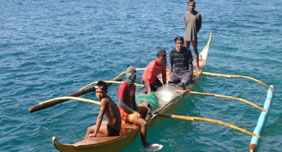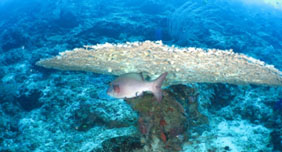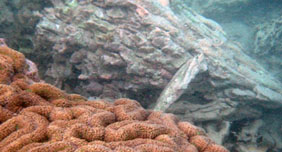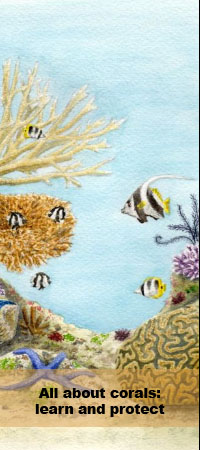|
Coral mining
The mining of coral for construction materials and lime has degraded reefs in East Africa, South Asia, South East Asia and the Pacific. Live coral colonies of species such as Platygyra, Porites and Favia are indiscriminately extracted from the reef flats as well as large portions of the calcium carbonate reef framework creating plumes of sediments and piles of rubble.
In many regions, corals are primarily extracted for the production of lime which is obtained when corals are broken and burned in kiln or open fire. This lime is then used in the production of mortar, white wash paints and use in cess pits. Approximately 1.8 kgs of coral is needed to produce 1 kg of lime. As well as being processed for lime, large fragments of extracted coral may also be used in construction works as bricks or road-fill.
In Indonesia, coral mining has been practiced by Bajo (‘sea gipsies’) communities (Hoga Island, Wakatobi marine national park) as a means of for maintaining their strong relationship with the ocean by creating dwellings on coral platforms set on reef flats after the Indonesian government insisted they moved into permanent houses. The platform for Bajo house is symbolic of their status and may reach sizes of 280m3. A healthy reef can supply approximately 0.2m3 of solid rock and coral per 1m2 therefore the construction of a single Bajo house platform may use a staggering 1400m2 of reef.
Recovery of corals from mining activity relies on the success of coral larvae recruitment. This can be affected by the availability of suitable hard substrate, disturbance (from coral rubble and predators) and water quality. After 20 years, the effects of mining activity in are still evident on a number of reefs in Wakatobi marine national park, Indonesia where mined sites have become characterised by low levels of live coral cover and species richness and an abundance of marine fauna usually associated with sandy areas.
Coral reefs: Suppliers of sand
Cyanide and dynamite fishing are destructive fishing techniques that have damaging effects on coral reef structures and ecosystems. Although illegal in many countries, cyanide and dynamite fishing continues to be practiced in un-policed areas, particularly in South East Asia. Cyanide fishing involves the use of the toxicant cyanide to temporality stun and collect reef fish for life fish industry and aquarium trade. Cyanide pellets are crushed and mixed with seawater before being squirted on to coral heads allowing fishermen to catch fish seeking refuge within the crevices of coral reef systems. Whilst the physical structure of the reef remains intact, cyanide toxicants can cause mass mortality in coral polyps as it disrupts the symbiotic relationship between the coral polyp hosts and zooxanthelle. For example, coral mortality was recorded in Porites and Pocillopora hard corals 7 days after exposure to 5200mg/litre of hydrogen cyanide for 10, 20 or 30 mins while hard and soft corals exposed to lower concentrations of hydrogen cyanide (50-60 mg/litre) died within 2 months of exposure. According to the Community Investment Forum (2001) loss of live coral cover in Indonesia as a result of cyanide fishing is approximately 0.052 m2 per 100 m2 of reef per year.
Dynamite or ‘blast’ fishing destroys living coral at a rate beyond its capacity to regenerate. Unlike cyanide fishing, dynamite fishing causes structural damage to coral reefs reducing them to fields of rubble as hard calcium carbonate coral skeletons shatter. Reef recovery from repeat blasts can be extremely slow as abrasive, shifting coral rubble damages surviving corals and new coral recruits struggle to settle amongst the mobile substrate. Recovery of coral is further hindered in heavily disturbed areas as they become dominated by macroalgae and soft coral species that out compete hard corals for space.
The practice of dynamite fishing in South East Asia has been widespread with devastating results. A survey of Komodo National Park in 1995 revealed that more than 50% of coral reefs in park had suffered damage from destructive fishing practices, primarily dynamite but also cyanide and gleaning. Recovery from dynamite fishing within the park has been slow. A three year study of coral recruitment at 9 rubble fields within the park (1998-2001) revealed low-level recruitment of 1-15 coral colonies per m2 as well as poor survival and growth rates of new coral recruits. As a result, hard coral cover in the rubble fields had not increased.
|
|

Illegal mining of coral for wall construction in the Philippines. © Endangered Species

Coral extraction from the sea for production of lime.
© Endangered Species International

Dynamite fishing is now illegal worldwide. © Endangered Species International

Dynamite or ‘blast’ fishing destroys living coral at a rate beyond its capacity to regenerate. © Endangered Species International

Structural damage of coral reef. © Endangered Species International

Structural destruction of coral reef. © Endangered Species International
|









